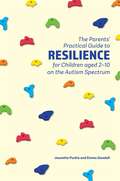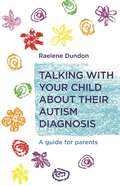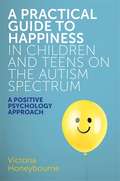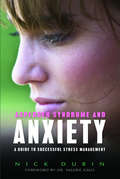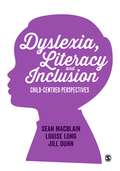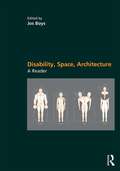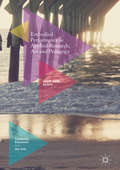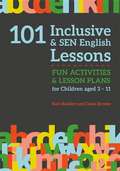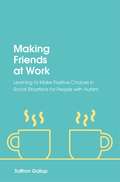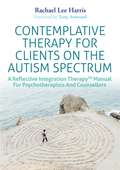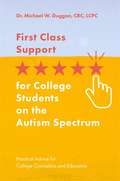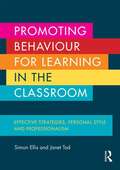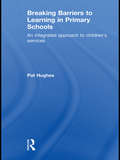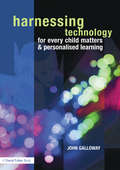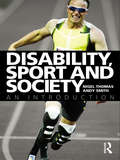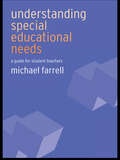- Table View
- List View
The Parents' Practical Guide to Resilience for Children aged 2-10 on the Autism Spectrum: Two to Ten Years
by Jeanette Purkis Emma GoodallChildren and young people with autism have the capacity to be independent and resilient which can help them live independently or be supported to live a fulfilling life and reach their full potential. This book empowers parents of autistic children aged two to ten to help them promote resilience in their child. Full of suggestions and simple activities, this easy-to-use resource will help guide parents on how to build the foundations of resilience and independence for situations such as school, new environments and relationships with other children. It includes information about the main developmental stages for children on the autism spectrum, and will take parents through life events and milestones at different ages and identify where difficulties and barriers to resilience may arise and how to address them.
Talking with Your Child about Their Autism Diagnosis: A Guide for Parents
by Raelene DundonTelling your child about their autism diagnosis can be daunting. Will they be better off for knowing? What's the right way to tell them? Should you inform anyone else too? As a mother of two children on the spectrum, with over ten years' experience as a psychologist specialising in childhood autism, Raelene Dundon has all the tips you'll need. In this concise book, she sets out case studies, examples and resources that will equip you to make your own informed choices and help your whole family to live well with autism. Part One provides ways to tell children of different ages and development levels about their diagnosis, including photocopiable and downloadable worksheets designed to help diagnosed children understand autism, and gives advice on what to do if they react in a negative or unexpected way to the news. Part Two explores the pros and cons of sharing the diagnosis with others, including family, friends, school staff and your child's classmates, and guides you through what to do if others don't understand or accept the diagnosis.
A Practical Guide to Happiness in Children and Teens on the Autism Spectrum: A Positive Psychology Approach
by Victoria HoneybourneFull of simple strategies for happiness in children and teens with autism, this book is a must read for anyone dedicated to the wellbeing of a child on the spectrum. Bringing a refreshingly positive approach to mental health and autism, the guide is full of practical ideas for helping children strengthen their self-worth, optimism and receptivity to happiness. It also reveals how children can build resilience and better understand their feelings, giving them the skills to flourish and thrive and to ward off negative thoughts. The activities are ideal for all learning levels and can be done individually or in groups, at home or in the classroom. Talking about mental health in autism is all too often reduced to ways of 'curing illness' - this book helps to prevent poor mental health by making happiness a priority and an attainable goal.
Asperger Syndrome and Anxiety: A Guide to Successful Stress Management
by Nick DubinMany people suffer from feelings of stress and anxiety in their everyday lives. For people with Asperger Syndrome (AS), this stress can be particularly difficult to manage. On a daily basis people with AS must fit into a world that seems totally foreign to them and this can increase feelings of alienation and anxiety, making life's challenges especially hard to cope with. The first book on anxiety written specifically for adults with Asperger Syndrome, this book offers practical advice on how individuals with AS can manage their anxiety more effectively. As a person with AS who has struggled with feelings of anxiety and learnt how to overcome them, Nick Dubin shares his own tried and tested solutions along with up-to-date research on stress management for individuals with AS, including a chapter on Cognitive Behavioural Therapy (CBT). Dubin explores the key problem areas that can lead to anxiety for people with AS such as lack of social skills, difficulties establishing romantic relationships and uncertainty about employment. Asperger Syndrome and Anxiety provides real solutions to a common problem and is essential reading for anyone with AS who has trouble managing stress. The book will also be of interest to family members, teachers and other professionals working with individuals with AS.
Asperger Syndrome and Anxiety: A Guide to Successful Stress Management (PDF)
by Nick DubinMany people suffer from feelings of stress and anxiety in their everyday lives. For people with Asperger Syndrome (AS), this stress can be particularly difficult to manage. On a daily basis people with AS must fit into a world that seems totally foreign to them and this can increase feelings of alienation and anxiety, making life's challenges especially hard to cope with. The first book on anxiety written specifically for adults with Asperger Syndrome, this book offers practical advice on how individuals with AS can manage their anxiety more effectively. As a person with AS who has struggled with feelings of anxiety and learnt how to overcome them, Nick Dubin shares his own tried and tested solutions along with up-to-date research on stress management for individuals with AS, including a chapter on Cognitive Behavioural Therapy (CBT). Dubin explores the key problem areas that can lead to anxiety for people with AS such as lack of social skills, difficulties establishing romantic relationships and uncertainty about employment. Asperger Syndrome and Anxiety provides real solutions to a common problem and is essential reading for anyone with AS who has trouble managing stress. The book will also be of interest to family members, teachers and other professionals working with individuals with AS.
Dyslexia, Literacy and Inclusion: Child-centred perspectives
by Sean Macblain Dr Jill Dunn Louise LongThis book is about raising standards in literacy for children with dyslexia by putting the child at the centre of everything you do, focusing on wellbeing, and recognising the role that adults have to play in ensuring all children reach their potential. Concentrating on children in primary schools and early years settings the book looks at: Early intervention Pupil voice Working as a team New literacies Child-centred identification, assessment and provision Challenges for the inclusive school. Suitable for all those working with children with dyslexia this book contains strategies that can be easily adopted to academically and emotionally benefit the children you are working with.
Dyslexia, Literacy and Inclusion: Child-centred perspectives
by Sean Macblain Dr Jill Dunn Louise LongThis book is about raising standards in literacy for children with dyslexia by putting the child at the centre of everything you do, focusing on wellbeing, and recognising the role that adults have to play in ensuring all children reach their potential. Concentrating on children in primary schools and early years settings the book looks at: Early intervention Pupil voice Working as a team New literacies Child-centred identification, assessment and provision Challenges for the inclusive school. Suitable for all those working with children with dyslexia this book contains strategies that can be easily adopted to academically and emotionally benefit the children you are working with.
Disability, Space, Architecture: A Reader (PDF)
by Jos BoysDisability, Space, Architecture: A Reader takes a groundbreaking approach to exploring the interconnections between disability, architecture and cities. The contributions come from architecture, geography, anthropology, health studies, English language and literature, rhetoric and composition, art history, disability studies and disability arts and cover personal, theoretical and innovative ideas and work. Richer approaches to disability #65533; beyond regulation and design guidance #65533; remain fragmented and difficult to find for architectural and built environment students, educators and professionals. By bringing together in one place some seminal texts and projects, as well as newly commissioned writings, readers can engage with disability in unexpected and exciting ways that can vibrantly inform their understandings of architecture and urban design. Most crucially, Disability, Space, Architecture: A Reader opens up not just disability but also ability #65533; dis/ability #65533; as a means of refusing the normalisation of only particular kinds of bodies in the design of built space. It reveals how our everyday social attitudes and practices about people, objects and spaces can be better understood through the lens of disability, and it suggests how thinking differently about dis/ability can enable innovative and new kinds of critical and creative architectural and urban design education and practice.
Disability, Space, Architecture: A Reader
by Jos BoysDisability, Space, Architecture: A Reader takes a groundbreaking approach to exploring the interconnections between disability, architecture and cities. The contributions come from architecture, geography, anthropology, health studies, English language and literature, rhetoric and composition, art history, disability studies and disability arts and cover personal, theoretical and innovative ideas and work. Richer approaches to disability #65533; beyond regulation and design guidance #65533; remain fragmented and difficult to find for architectural and built environment students, educators and professionals. By bringing together in one place some seminal texts and projects, as well as newly commissioned writings, readers can engage with disability in unexpected and exciting ways that can vibrantly inform their understandings of architecture and urban design. Most crucially, Disability, Space, Architecture: A Reader opens up not just disability but also ability #65533; dis/ability #65533; as a means of refusing the normalisation of only particular kinds of bodies in the design of built space. It reveals how our everyday social attitudes and practices about people, objects and spaces can be better understood through the lens of disability, and it suggests how thinking differently about dis/ability can enable innovative and new kinds of critical and creative architectural and urban design education and practice.
Embodied Performance as Applied Research, Art and Pedagogy
by Julie-Ann ScottThis book follows a physically disabled researcher's journey from stigmatized embodiment on her way to creating accessible storytelling performances. These unique performances function not only as traditional, peer-reviewed forms of critical qualitative research, but also as ‘narrative teaching productions’ that guide students and their audiences in the pursuit of social justice and equality. The book begins by developing the author's personal standpoint, and provides an evocative discussion of the multiple perceptions and identities experienced by those with disabled bodies. It negotiates how performance research can be created and conducted within the confines of course learning objectives, moves through complications encountered in research design and data collection, and explores a range of insightful responses from community members, social activists, and performance critics, as well as more traditional academic audiences. Critical autoethnographic personal narratives, performance scripts, and poetry are used to illuminate struggles over legitimate methodological practice and storytelling performance pedagogy. Each chapter confronts the fear of mortality that presses us to stigmatize those who remind us of our inescapably vulnerable embodiments and offers hope for an inclusive, adaptable culture. The book will be compelling reading for scholars in Performance Studies, Disability Studies, Cultural Studies, Narrative Methodology, Ethnography, Higher Education, Autoethnography, Creative Nonfiction and everyone interested embodiment and/or storytelling for social change.Please visit www.uncwstorytelling.org/chapter-summaries-1 to access supplementary material for the book.
Embodied Performance as Applied Research, Art and Pedagogy
by Julie-Ann ScottThis book follows a physically disabled researcher's journey from stigmatized embodiment on her way to creating accessible storytelling performances. These unique performances function not only as traditional, peer-reviewed forms of critical qualitative research, but also as ‘narrative teaching productions’ that guide students and their audiences in the pursuit of social justice and equality. The book begins by developing the author's personal standpoint, and provides an evocative discussion of the multiple perceptions and identities experienced by those with disabled bodies. It negotiates how performance research can be created and conducted within the confines of course learning objectives, moves through complications encountered in research design and data collection, and explores a range of insightful responses from community members, social activists, and performance critics, as well as more traditional academic audiences. Critical autoethnographic personal narratives, performance scripts, and poetry are used to illuminate struggles over legitimate methodological practice and storytelling performance pedagogy. Each chapter confronts the fear of mortality that presses us to stigmatize those who remind us of our inescapably vulnerable embodiments and offers hope for an inclusive, adaptable culture. The book will be compelling reading for scholars in Performance Studies, Disability Studies, Cultural Studies, Narrative Methodology, Ethnography, Higher Education, Autoethnography, Creative Nonfiction and everyone interested embodiment and/or storytelling for social change.Please visit www.uncwstorytelling.org/chapter-summaries-1 to access supplementary material for the book.
101 Inclusive and SEN English Lessons: Fun Activities and Lesson Plans for Children Aged 3 – 11
by Claire Brewer Kate BradleyCreate an inclusive classroom for all with this resource, full of ideas for engaging and accessible English lessons. Each lesson is tailored to objectives for children working below National Curriculum levels and includes a learning objective, the resources needed, the main activity, a plenary and a consolidation activity to help support children's understanding. When working with children, and especially those with SEN, lessons need to meet their interests as well as their needs by containing visual stimulus and promoting fine and gross motor skills, and the activities in this book have been specifically designed with this in mind. This straightforward and practical book offers you 101 creative classroom activities for teaching English to pupils who are achieving at P Levels 4 - 8, as well as mapping the range of additional skills they will acquire.
Making Friends at Work: Learning to Make Positive Choices in Social Situations for People with Autism
by Saffron GallupMaking new friends at work can be tricky - it's tough to predict how people will react to certain situations. This 'choose your own response' book can show you how these situations could potentially play out. Some endings are positive and some less so, and the book includes explanations about why particular outcomes may have occurred, so you can learn to avoid those situations. The best part is you can go back and see how a different choice can change the outcome of the story!
Making Friends at Work: Learning to Make Positive Choices in Social Situations for People with Autism
by Saffron GallupMaking new friends at work can be tricky - it's tough to predict how people will react to certain situations. This 'choose your own response' book can show you how these situations could potentially play out. Some endings are positive and some less so, and the book includes explanations about why particular outcomes may have occurred, so you can learn to avoid those situations. The best part is you can go back and see how a different choice can change the outcome of the story!
Contemplative Therapy for Clients on the Autism Spectrum: A Reflective Integration Therapy™ Manual for Psychotherapists and Counsellors
by Rachael Lee Harris Tony AttwoodDrawing on the ancient tradition of contemplation, Reflective Integration Therapy™ shows how mantra meditation and reflective therapy can be used with clients with high functioning autism. The Reflective Integration Therapy™ programme uses the cognitive differences in those with autism, such as their innate capacity for silence, withdrawal, intense focus and repetition as sources of therapeutic healing. This manual introduces this fresh, unique therapeutic approach, creating an essential resource for all practitioners working in the field of autism. All the material for twelve weekly sessions of therapy is included within the book.
First Class Support for College Students on the Autism Spectrum: Practical Advice for College Counselors and Educators
by Michael W. DugganCollege students with autism can face many difficulties during the transition from high school to further education and beyond. Highlighting the various everyday issues that may arise, this book shares practical advice for supporting students on the autism spectrum and helping them to succeed not only academically, but also socially and emotionally. From supporting students with their relationships, to dealing with anxiety and managing independent living, this book covers a breadth of topics. It considers the impact of teaching expectations in higher learning on general adult life, and how to counsel students with autism on academic issues. The author also examines his many years of experience as a community college counselor, sharing the mistakes he has made and the lessons learned, to outline what makes a good counselor and how to take specific steps to ensure success for students with autism in all aspects of college life.
Promoting Behaviour For Learning In The Classroom: Effective Strategies, Personal Style And Professionalism (PDF)
by Simon Ellis Janet TodPromoting Behaviour for Learning in the Classroom offers essential support to help you develop capacity and confidence in managing behaviour in the group setting of the classroom. It provides a concise analysis of established behaviour management strategies, recognising that no single approach will work for all pupils and that central to effective practice is an understanding of the different personal attributes and experiences teachers and pupils bring to the classroom Illustrated by examples from the classroom, Promoting Behaviour for Learning in the Classroom uses the tried and tested #65533;Behaviour for Learning#65533; framework to show how teachers#65533; expertise in promoting learning can be used to improve behaviour. Key issues considered include: Developing positive relationships in the classroom Understanding personal style and self-management Effective use of feedback and rewards Using positive correction and sanctions Working with school systems and frameworks for managing behaviour Individual differences and special educational needs Dealing with challenging behaviour Written by experts in the field, Promoting Behaviour for Learning in the Classroom offers much-needed in-depth, realistic support and guidance to show teachers how to improve learning and behaviour in the group setting of the classrooms.
Breaking Barriers To Learning In Primary Schools: An Integrated Approach To Children's Services
by Pat HughesBreaking Barriers to Learning in Primary Schoolstakes an expert and informative look at the integrated children's services agenda in practice in today's primary schools. Examining the ways in which an increasing number of different professionals help to improve children's life chances, the author examines the roles of those employed directly by the schools themselves, for instance Learning Mentors, HLTAs and Teaching Assistants, and those employed by health/social and other agencies, such as school nurses, Educational social workers, study support workers, school attendance workers and Educational Psychologists. Through an exploration of how each individual helps break down barriers to children's learning, this book: examines the growth and development of the children's workforce provides a broad and integrated view of the wider school network explores the roles of individuals within the school workforce makes links to Every Child Matters and Extended Schools initiatives provides evidences of breaking down barriers, through interviews and studies with those working at the heart of integrated schools presents an analysis of recent statistics relating to children's lives gives practical advice for good practice throughout. An essential text for all those working in education and in training to become part of this wider school network, this book takes into account the findings of the recent Primary Reviews, government data and original research to fully explain how to build, maintain and successfully work with today's primary children. It is an excellent text for Foundation Degree students as well as those studying Education Studies and those training to be teachers.
Breaking Barriers To Learning In Primary Schools: An Integrated Approach To Children's Services (PDF)
by Pat HughesBreaking Barriers to Learning in Primary Schoolstakes an expert and informative look at the integrated children's services agenda in practice in today's primary schools. Examining the ways in which an increasing number of different professionals help to improve children's life chances, the author examines the roles of those employed directly by the schools themselves, for instance Learning Mentors, HLTAs and Teaching Assistants, and those employed by health/social and other agencies, such as school nurses, Educational social workers, study support workers, school attendance workers and Educational Psychologists. Through an exploration of how each individual helps break down barriers to children's learning, this book: examines the growth and development of the children's workforce provides a broad and integrated view of the wider school network explores the roles of individuals within the school workforce makes links to Every Child Matters and Extended Schools initiatives provides evidences of breaking down barriers, through interviews and studies with those working at the heart of integrated schools presents an analysis of recent statistics relating to children's lives gives practical advice for good practice throughout. An essential text for all those working in education and in training to become part of this wider school network, this book takes into account the findings of the recent Primary Reviews, government data and original research to fully explain how to build, maintain and successfully work with today's primary children. It is an excellent text for Foundation Degree students as well as those studying Education Studies and those training to be teachers.
Harnessing Technology for Every Child Matters and Personalised Learning
by John GallowayThis book takes into account three core policies: 'Every Child Matters', 'Personalised Learning', and 'Harnessing Technology', combined they are at the heart of changes to children and young peoples’ experiences of school. Harnessing Technology considers these policies and their interlinked relationship. It outlines the ways in which technology allows us to assess, track and monitor pupil progress and use this information to better support both their learning and their broader needs, making it an essential resource for training and practicing teachers, school leaders, and all those involved in educational transformation. To achieve the five outcomes of the 'Every Child Matters' agenda requires an approach that is pupil centred, with developments in new technologies making it possible to not only understand each individual more precisely, but also for them to learn in more flexible and personalised ways. Through innovations such as web based information sharing, learning platforms and e-portfolios, schools will be able to offer content appropriate to pupil’s personal goals, breaching conventional orthodoxies of time and place. How far these policies will transform schools and services for children and young people remains to be seen. Consideration is given within the book to the barriers to their success, the issues that impinge upon them, and questions asked about their capacity to bring about long-term, systemic, change.
Harnessing Technology for Every Child Matters and Personalised Learning
by John GallowayThis book takes into account three core policies: 'Every Child Matters', 'Personalised Learning', and 'Harnessing Technology', combined they are at the heart of changes to children and young peoples’ experiences of school. Harnessing Technology considers these policies and their interlinked relationship. It outlines the ways in which technology allows us to assess, track and monitor pupil progress and use this information to better support both their learning and their broader needs, making it an essential resource for training and practicing teachers, school leaders, and all those involved in educational transformation. To achieve the five outcomes of the 'Every Child Matters' agenda requires an approach that is pupil centred, with developments in new technologies making it possible to not only understand each individual more precisely, but also for them to learn in more flexible and personalised ways. Through innovations such as web based information sharing, learning platforms and e-portfolios, schools will be able to offer content appropriate to pupil’s personal goals, breaching conventional orthodoxies of time and place. How far these policies will transform schools and services for children and young people remains to be seen. Consideration is given within the book to the barriers to their success, the issues that impinge upon them, and questions asked about their capacity to bring about long-term, systemic, change.
Disability, Sport and Society: An Introduction
by Nigel Thomas Andy SmithDisability sport is a relatively recent phenomenon, yet it is also one that, particularly in the context of social inclusion, is attracting increasing political and academic interest. The purpose of this important new text – the first of its kind – is to introduce the reader to key concepts in disability and disability sport and to examine the complex relationships between modern sport, disability and other aspects of wider society. Drawing upon original data from interviews, surveys and policy documents, the book examines how disability sport has developed and is currently organised, and explores key themes, issues and concepts including: disability theory and policy the emergence and development of disability sport disability sport development in local authorities mainstreaming disability sport disability, physical education and school sport elite disability sport and the Paralympic Games disability sport and the media. Including chapter summaries, seminar questions and lists of key websites and further reading throughout, Sport, Disability and Society provides both an easy to follow introduction and a critical exploration of the key issues surrounding disability sport in the twenty-first century. This book is an invaluable resource for all students, researchers and professionals working in sport studies, disability studies, physical education, sociology and social policy. Nigel Thomas is Head of Sport and Exercise at Staffordshire University, UK, where his research focuses on the history, mainstreaming, and media coverage of disability sport. He previously worked for ten years with young disabled people as a sports development officer in local authorities and national governing bodies. Andy Smith is Lecturer in the Sociology of Sport and Exercise at the University of Chester, UK. He is a co-editor of the International Journal of Sport Policy, and a co-author of Sport Policy and Development: A Sociological Introduction, and An Introduction to Drugs in Sport: Addicted to Winning? Both books are published by Routledge (2009).
Disability, Sport and Society: An Introduction
by Nigel Thomas Andy SmithDisability sport is a relatively recent phenomenon, yet it is also one that, particularly in the context of social inclusion, is attracting increasing political and academic interest. The purpose of this important new text – the first of its kind – is to introduce the reader to key concepts in disability and disability sport and to examine the complex relationships between modern sport, disability and other aspects of wider society. Drawing upon original data from interviews, surveys and policy documents, the book examines how disability sport has developed and is currently organised, and explores key themes, issues and concepts including: disability theory and policy the emergence and development of disability sport disability sport development in local authorities mainstreaming disability sport disability, physical education and school sport elite disability sport and the Paralympic Games disability sport and the media. Including chapter summaries, seminar questions and lists of key websites and further reading throughout, Sport, Disability and Society provides both an easy to follow introduction and a critical exploration of the key issues surrounding disability sport in the twenty-first century. This book is an invaluable resource for all students, researchers and professionals working in sport studies, disability studies, physical education, sociology and social policy. Nigel Thomas is Head of Sport and Exercise at Staffordshire University, UK, where his research focuses on the history, mainstreaming, and media coverage of disability sport. He previously worked for ten years with young disabled people as a sports development officer in local authorities and national governing bodies. Andy Smith is Lecturer in the Sociology of Sport and Exercise at the University of Chester, UK. He is a co-editor of the International Journal of Sport Policy, and a co-author of Sport Policy and Development: A Sociological Introduction, and An Introduction to Drugs in Sport: Addicted to Winning? Both books are published by Routledge (2009).
Understanding Special Educational Needs: A Guide for Student Teachers
by Michael FarrellTeachers need to be fully equipped to respond to diversity in today's classrooms now more than ever before. The Professional Standards for Qualified Teacher Status and Induction Standards are now the driving force behind initial teacher education, and students will need to demonstrate their competence against these, and in particular, their understanding of Special Educational Needs in today's inclusive classrooms. Each chapter of this indispensable text explores an important topic within SEN and directly relates it to the competencies, making it an essential course companion. Chapters on topics relating to the code of practice, school policy, literacy and numeracy, ICT, emotional and behavioural difficulties and dealing with parents all follow a similar template, which includes: a commentary on the relevant professional standards contextualising of the standards what teachers can do to promote effective practice. Detailed referencing will lead students to pursue more detailed individual texts, which address many of the issues in greater depth. This is an ideal, highly accessible text for student and new qualified teachers who need a reliable introduction to today's vital issues within Special Educational Needs.
Understanding Special Educational Needs: A Guide for Student Teachers
by Michael FarrellTeachers need to be fully equipped to respond to diversity in today's classrooms now more than ever before. The Professional Standards for Qualified Teacher Status and Induction Standards are now the driving force behind initial teacher education, and students will need to demonstrate their competence against these, and in particular, their understanding of Special Educational Needs in today's inclusive classrooms. Each chapter of this indispensable text explores an important topic within SEN and directly relates it to the competencies, making it an essential course companion. Chapters on topics relating to the code of practice, school policy, literacy and numeracy, ICT, emotional and behavioural difficulties and dealing with parents all follow a similar template, which includes: a commentary on the relevant professional standards contextualising of the standards what teachers can do to promote effective practice. Detailed referencing will lead students to pursue more detailed individual texts, which address many of the issues in greater depth. This is an ideal, highly accessible text for student and new qualified teachers who need a reliable introduction to today's vital issues within Special Educational Needs.
